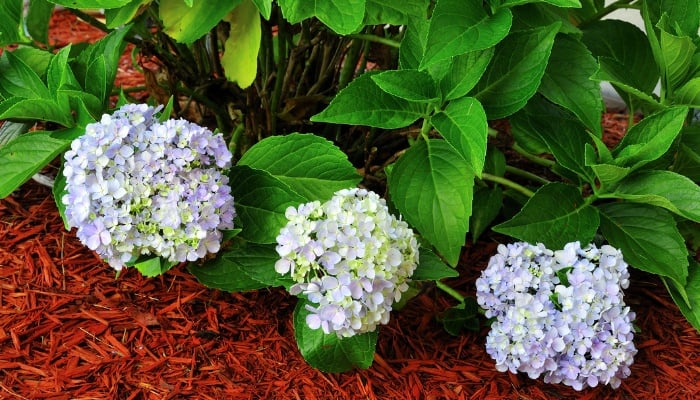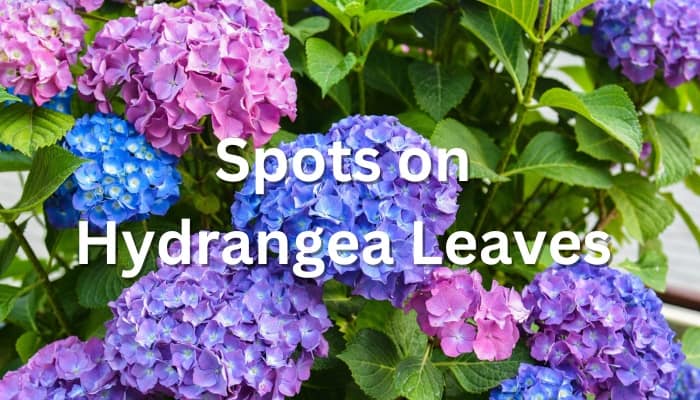If you encounter any difficulties while attempting to rewrite the text, please reply with the following error message: Unable to process the request due to encountered difficulties.
To effectively address spots on hydrangea leaves, it is recommended to carefully remove any severely damaged leaves using sanitized pruners and then apply a copper-based fungicide to any mildly affected areas. In cases where potted plants are infected, repotting in new soil may be necessary to eliminate any remaining spores.
As always, prevention is the best cure, so it’s super important that you sustain healthy growing conditions for your hydrangea in terms of daily care and long-term pruning and maintenance.
Spots on Hydrangea Leaves
Spots on hydrangea foliage can begin as a few dots before spreading into large patches that can destroy the look and health of your plant.
To get to the bottom of the leaf spot problem, let’s discover the particular spot issue on your hydrangea leaves, what causes them to appear, and how to fix them.
White Spots on Hydrangea Leaves
Microscopic spores settle in clusters on the leaf surface, forming a visible but thin layer of white powder on the surface.
As it spreads, solid specks and patches of white appear with some spots forming brown/red centers.
Causes
Warm days and cool nights create a humid microclimate, especially on hydrangea bushes that are crowded and unpruned, allowing fungal spores that are carried by the wind and rain to germinate on the leaves.
Soggy soil and drought stress can also invite fungal disease into the soil that then travels up the stems, later displaying signs on the leaves.
Treatment
- Remove badly infected leaves with clean pruners, and for those with minimal damage, you can spot-treat the spots. Use a simple mix of 50/50 soapy water and rubbing alcohol and a clean cloth to gently wipe the leaves clean.
- Most natural fungicide sprays can also be applied to the leaves.
- Reduce humidity and invite better air circulation by pruning out old stems.
Yellow Spots on Hydrangea Leaves
Sometime between mid-summer and early fall, leaves develop small yellow or light-tan spots, forming dark rings around their edges as they spread.
Spots can develop into large-scale mottling if unaddressed, and you may also notice cankers appearing on the stems or branches.
Causes
Pest attacks by sap-sucking aphids and spider mites can be a common cause as the leaf vigor becomes weakened in specific areas.
It can also be caused by the fungus Anthracnose with spores overwintering in leaf debris. As the weather warms in spring, spores spread to the plant by rain splash and irrigation water.
Treatment
- Remove and destroy heavily spotted leaves and collect any fallen leaves.
- Spray all foliage and blooms with a copper-based fungicide. Bonide Copper Fungicide Dust is a gentle, organic option.
- Use a natural pesticide such as neem oil on remaining healthy leaves or those with minimal spot damage.
Brown Spots on Hydrangea Leaves
Toward the end of summer, small brown spots on the leaves might appear. These are circular at first but become irregular as they grow and come into contact with leaf veins.
Lighter or darker rings appear around the sunken center spots, creating a bull’s eye appearance, and spots may spread to blooms.
Causes
Brown spots often occur on leaves that regularly remain wet after watering or rainy periods. Coupled with humid conditions, this invites the Anthracnose or Cercospora leaf spot fungus to settle.
Cercospora tends to have brown centers and purple edges and has a slower spread, while Anthracnose symptoms can appear simultaneously on leaves and flowers.
Treatment
- To treat brown spots on hydrangeas, prune out badly infected leaves and apply commercial copper-based fungicides.
- You can also spray minimally damaged leaves with compost tea or liquid kelp to help prevent pathogens and increase your plant’s resistance to environmental stress.
- If your hydrangea is potted, now’s a good opportunity to repot in fresh soil. This helps to kill off any remaining spores and prevent a new infection cycle.
Black Spots on Hydrangea Leaves
Small circular dark spots appear, becoming sunken and depressed over time. Dead plant tissue at the center of the spot can later fall out, creating the look of shot holes in the leaves.
If the gardener allows this to spread, these spots can appear on the stems and flowers too.
Causes
A small number of spots on one or two leaves may indicate stress, especially on young plants that have been newly transplanted.
Black spots across many leaves can be a sign that your plant is lacking in phosphorus. This can occur in soil that is too alkaline or too acidic (hydrangeas love soil that is around 5.5 pH), so perform a soil test to find out for sure.
Bug infestations may also lead to black or dark sunken spots in the leaves.
Treatment
- A spray of copper fungicide every couple of weeks can help to kill the spread. Apply the same fungicide the following spring to prevent and stop a repeat infection.
- Make sure your soil type and pH are suited to your hydrangea.
- Spray infected leaves with a natural insecticide like soapy water solution or neem oil.
Common Hydrangea Leaf Diseases
There are several plant diseases that can blight your hydrangea leaves, some of which we’ve alluded to above. Here are the most common problems and tips to deal with them.
Cercospora Leaf Spot
- Appearance: Brown/purple spots on the upper and underside of leaves.
- Tips: Avoid overhead watering, and spray with fungicide containing chlorothalonil.
Anthracnose
- Appearance: Black/tan spots with reddish-purple rings.
- Tips: Apply copper fungicide and use fertilizer sparingly as this can stress the plant and attract pathogens.
Rust
- Appearance: Orange patches on leaf undersides and yellow lesions/brown patches on the upper surface.
- Tips: Avoid overhead watering, use a hydrogen peroxide spray, and consider growing the ‘Frosty’ hydrangea variety as this is rust-resistant.
Alternaria Leaf Spot
- Appearance: Dark brown or black spots with yellow halo rings. Lesions may develop on leaf edges.
- Tips: Apply copper fungicide, and remove fallen diseased leaves from the area.
Phyllosticta Leaf Spot
- Appearance: Irregular or v-shaped tan/gray lesions, appearing like wood grain as it spreads.
- Tips: Destroy affected leaves, and encourage healthy growth by mulching to preserve moisture and minimize water stress.
Bacterial Leaf Spot
- Appearance: Angular grayish/white spots with black rings that form patches as it spreads.
- Tips: Cut back old stems to encourage airflow, and spray infected leaves with compost tea.
Hydrangea Ringspot Virus
- Appearance: Faint yellow patches with halo rings, spreading to create a yellow mosaic pattern.
- Tips: This virus is spread by pollen and nematodes, so there is no chemical treatment. You can prevent it by planting in sterile soil or waiting a year to replant in the same spot as the virus can survive in leftover root material.

Preventing Spots on Hydrangea Leaves
- Maintain a good watering schedule. Hydrangeas need about an inch per week, spread out every few days so the soil can dry out between watering.
- Water at the base of the plant using a drip system or hose, and never water with an overhead sprinkler.
- Clear all fallen debris beneath your hydrangea bush and in the vicinity to prevent fungal spores from getting too cozy and ready to pounce!
- Keep pests at bay by planting pest-repelling companion plants. Also, keep the area free of weeds, and avoid using thick layers of mulch as this can provide cover for many pests.
- Avoid overfertilizing as this will make your hydrangea more vulnerable to disease. Hydrangeas can benefit from one application in early spring and again in early summer to boost bloom production.
- Prune out old stems regularly to promote air circulation, but take care not to remove more than 1/3 as your hydrangea may not cope well!
- Super important! Clean your tools — disinfect your pruning shears, clippers, and any other tools before and after use in a bleach water solution to prevent bacterial spread.
- Consider planting a disease-resistant hydrangea variety such as ‘Fuji Waterfall’ and ‘Trophy’.
Treating Hydrangea Leaf Spots
Treat infected areas as soon as possible with a copper-based fungicide, and repeat the application as directed the following spring to arm your hydrangea against infection in the new season.
Don’t forget to target the underside of the leaves as well!
Remove and destroy infected leaves and blooms upon sight, and place them in a tied garbage bag.
Related Questions:
What Is the Best Fungicide for Hydrangea Leaf Spot?
Broad-spectrum fungicides containing chlorothalonil or thiophanate-methyl are regarded as the most effective treatments for leaf spots on hydrangeas as these compounds help to remove both the Anthracnose and Cercospora fungus.
Use as directed on the product label, or apply more often for severe symptoms.
Why Are My Hydrangea Leaves Curling?
Curling hydrangea leaves can often indicate improper watering. Severe past damage can also cause leaves to curl on young hydrangeas as the new growth is vulnerable to sap-sucking insects.
Yellowing foliage coupled with curling can be a sign of viral disease, but this is a rare cause of curling.
Final Thoughts About Spots on the Leaves of Your Hydrangea
Leaf spot diseases are a nasty sight on your beautiful hydrangea plant, but they can often be managed.
The disease itself will not kill your plant, but the sheer spread of it can be fatal due to mass foliage loss, so identifying and treating it quickly is key.
Though leaf spot diseases come in different forms, the treatment and prevention methods are generally the same.
A fungicide suited to hydrangeas should be applied to infected areas, and good care practices should be maintained to keep stress at a minimum (from watering frequency and technique to how often you clear up plant debris).
Here’s to healthy hydrangea shrubs!

